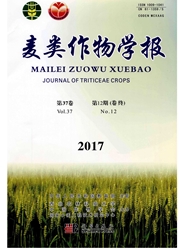

 中文摘要:
中文摘要:
为深入了解不同小麦基因型对UV-B辐射响应的差异,以中国黄淮地区140个冬小麦育成品种(系)为材料,在苗期施加4.3kJ·m^-2·d^-1的UV-B辐射,培养15d后,测定相关的生物量(株高、鲜重、干重)、色素相对含量(花青素、叶绿素、类胡萝卜素)及光化学植被指数(PRI)等指标,计算UV-B辐射下的响应指数,并根据冬小麦幼苗干重响应指数对140个品种(系)进行了UV-B耐性分类。结果表明,140个冬小麦幼苗的7个被检测指标对UV-B辐射的响应不尽相同。对7个被测指标响应指数的相关性分析发现,反映植物生物量指标的响应指数与色素指标的响应指数之间没有显著相关性。有39个品种(系)的幼苗对UV-B辐射敏感,其中,9305031-2的干重降低幅度最大(34.8%);抗UV-B辐射的品种(系)有36个,其中,京10531干重增加幅度最大(71.0%);其他65个品种(系)对UV-B辐射不敏感。
 英文摘要:
英文摘要:
In order to understand the responses of different wheat genotypes to ultraviolet-B(UV-B)radiation,the UV-B responses of 140 winter wheat varieties collected from Huang Huai Region in China were studied at seedling stage under 4.3kJ·m~(-2)·d~(-1) UV-B radiation for 15 days in the phytotron.To evaluate the tolerance of wheat seedlings,related indices,such as plant biomass(plant height,fresh weight and dry weight),concentrations of pigment(anthocyanin,chlorophyll and carotenoid)and photochemical reflectance index(PRI)were measured.The results showed that differences of seven indices existed among 140 winter wheat varieties under UV-B treatment.Correlation analysis showed that there was no significant correlation between the response indices(RIs)of plant biomass and the RIs of pigment.According to the RI of dry weight,39 cultivars were sensitive to UV-B,of which the variety 9305031-2displayed the highest reduction in dry weight(34.8%);while 36 varieties were resistant to UV-B radiation,of which the variety Jing 10531 exhibited the highest increase in dry weight(71.0%);and other 65 winter wheats were not sensitive to UV-B radiation.
 同期刊论文项目
同期刊论文项目
 同项目期刊论文
同项目期刊论文
 期刊信息
期刊信息
